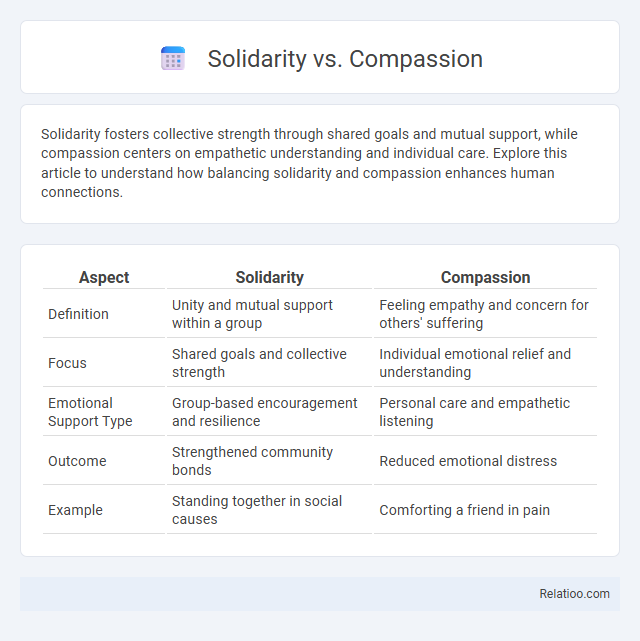Solidarity fosters collective strength through shared goals and mutual support, while compassion centers on empathetic understanding and individual care. Explore this article to understand how balancing solidarity and compassion enhances human connections.
Table of Comparison
| Aspect | Solidarity | Compassion |
|---|---|---|
| Definition | Unity and mutual support within a group | Feeling empathy and concern for others' suffering |
| Focus | Shared goals and collective strength | Individual emotional relief and understanding |
| Emotional Support Type | Group-based encouragement and resilience | Personal care and empathetic listening |
| Outcome | Strengthened community bonds | Reduced emotional distress |
| Example | Standing together in social causes | Comforting a friend in pain |
Defining Solidarity and Compassion
Solidarity represents a collective unity where individuals support a common cause, emphasizing shared responsibility and mutual commitment. Compassion involves recognizing another's suffering and responding with empathetic concern and a desire to alleviate pain. Your understanding of these concepts deepens when distinguishing solidarity's focus on collective action from compassion's personal emotional connection.
Historical Roots of Solidarity and Compassion
Solidarity traces its historical roots to labor movements and social justice efforts in the 19th and 20th centuries, emphasizing collective unity for shared goals. Compassion, with origins in religious and philosophical traditions, centers on empathy and concern for individual suffering. Understanding these foundations helps you appreciate how solidarity mobilizes group action, while compassion drives personal care.
Key Differences Between Solidarity and Compassion
Solidarity involves collective unity and mutual support within a group facing common challenges, emphasizing shared goals and actions. Compassion is an individual emotional response characterized by empathy and a desire to alleviate suffering, often without direct involvement in the affected group's struggle. Key differences lie in solidarity's focus on active collaboration and social unity, whereas compassion centers on personal empathy and concern.
Psychological Foundations of Solidarity
Solidarity is rooted in shared identity and collective goals, fostering a psychological sense of belonging and mutual support. Compassion involves empathy and emotional concern for others' suffering, motivating helping behaviors on an individual level. Solidarity combines these elements, emphasizing interconnectedness and sustained commitment to group welfare based on shared values and social cohesion.
Emotional Drivers Behind Compassion
Compassion is primarily driven by an emotional response to another's suffering, marked by empathy and a deep desire to alleviate pain. Unlike solidarity, which emphasizes shared commitment and collective action often based on common identity or goals, compassion connects on a personal level, motivating individuals to provide care regardless of group affiliation. Emotional drivers such as empathy, kindness, and altruism underpin compassionate behavior, making it a powerful catalyst for both individual support and broader social change.
Social Impact of Solidarity Movements
Solidarity movements foster collective action that amplifies marginalized voices and drives systemic change by uniting individuals around shared goals and mutual support. Unlike compassion, which emphasizes emotional concern for others, solidarity builds structural power through active collaboration and sustained engagement in social justice efforts. The social impact of solidarity movements is evident in policy reforms, community empowerment, and increased social cohesion that challenge inequalities and promote inclusive progress.
Compassion in Individual and Collective Contexts
Compassion in individual contexts manifests as empathy-driven actions aimed at alleviating personal suffering, fostering emotional connection and support. In collective contexts, compassion extends to societal structures, promoting inclusive policies and community initiatives that address systemic inequalities and enhance social well-being. Unlike solidarity, which emphasizes shared goals and mutual support among groups, compassion centers on understanding and responding to the emotional states of others at both personal and societal levels.
Practical Examples: Solidarity vs Compassion in Action
Solidarity in action often involves collective efforts like organizing community clean-ups or union strikes to address systemic issues, while compassion typically appears in personal acts such as volunteering at shelters or providing emotional support to individuals in need. Your choice between solidarity and compassion influences whether you contribute to broad social change or offer direct relief to those suffering. Both approaches are essential, and understanding when to apply each can maximize the impact of your social engagement.
Challenges of Balancing Solidarity and Compassion
Balancing solidarity and compassion presents challenges such as maintaining collective unity without compromising individual empathy, which can sometimes lead to conflicts between group loyalty and personal care. You may struggle to prioritize between supporting a community's goals and addressing the nuanced needs of individuals within that group. Effective strategies involve fostering inclusive environments that honor both shared commitments and compassionate understanding to navigate these tensions.
Building a Society That Values Both
Building a society that values both solidarity and compassion requires fostering a culture where collective responsibility meets empathetic understanding. Solidarity emphasizes unity and shared goals among diverse groups, while compassion focuses on recognizing and addressing individual suffering with kindness. By integrating these principles, you can create a resilient community that supports each member through both collective action and personal care.

Infographic: Solidarity vs Compassion
 relatioo.com
relatioo.com